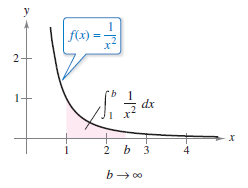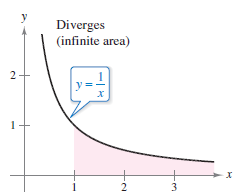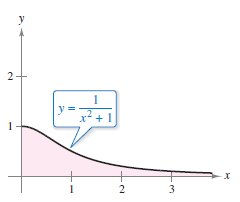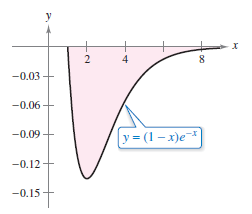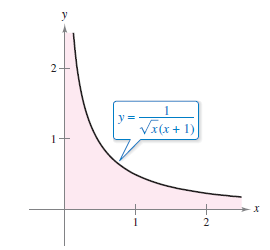Calculus II 08.08 Improper Integrals
| Previous | Calculus II 08.06 Integration by Tables and Other Integration Techniques |
| Next | Calculus II 09 Infinite Series |
Contents
- 1 8.8 Improper Integrals[1]
- 1.1 Improper Integrals with Infinite Integration Limits
- 1.1.1 Definition 8.8.1 Improper Integrals with Infinite Integration Limits
- 1.1.2 Example 8.8.1 An Improper Integral That Diverges
- 1.1.3 Example 8.8.2 Improper Integrals that Converge
- 1.1.4 Example 8.8.3 Using L’Hôpital’s Rule with an Improper Integral
- 1.1.5 Example 8.8.4 Infinite Upper and Lower Limits of Integration
- 1.1.6 Example 8.8.5 Sending a Spacecraft into Orbit
- 1.2 Improper Integrals with Infinite Discontinuities
- 1.2.1 Definition 8.8.2 Improper Integrals with Infinite Discontinuities
- 1.2.2 Example 8.8.6 An Improper Integral with an Infinite Discontinuity
- 1.2.3 Example 8.8.7 An Improper Integral That Diverges
- 1.2.4 Example 8.8.8 An Improper Integral with an Interior Discontinuity
- 1.2.5 Example 8.8.9 A Double Improper Integral
- 1.2.6 Example 8.8.10 An Application Involving Arc Length
- 1.3 Theorem 8.8.1 Improper Integral that is Bounded and Unbounded
- 1.1 Improper Integrals with Infinite Integration Limits
- 2 Internal Links
8.8 Improper Integrals[1]
- Evaluate an improper integral that has an infinite limit of integration.
- Evaluate an improper integral that has an infinite discontinuity.
Improper Integrals with Infinite Integration Limits
|
The definition for a definite integral
requires that the interval \([a,b]\) be finite and that \(f\) be continuous on \([a,b]\). This is called a proper integral. An improper integral has \( \infty \) as either or both limits or \(f\) has infinite discontinuities on the interval \([a,b]\). A function \(f\) has an infinite discontinuities at \(c\) from the right or left,
Consider the improper integral
which is described graphically as the shaded region shown in Figure 8.8.1. Taking the limit as \(b \to \infty\) produces
This improper integral can be interpreted as the area for the unbounded region between the graph for \(f(x)=1/x^{2}\) and the \(x\)-axis on the interval \([0,1]\). |
Definition 8.8.1 Improper Integrals with Infinite Integration Limits
1. If \(f\) is continuous on the interval \([a, \infty)\), then
- $$ \int_{a}^{ \infty } f(x)\:dx = \lim_{b \to \infty } \int_{a}^{b} f(x)\:dx . $$
2. If \(f\) is continuous on the interval \(( -\infty, b]\), then
- $$ \int_{ - \infty }^{b} f(x)\:dx = \lim_{a \to -\infty } \int_{a}^{b} f(x)\:dx . $$
3. If \(f\) is continuous on the interval \(( -\infty, \infty) \), then
- $$ \int_{ - \infty }^{ \infty} f(x)\:dx = \int_{-\infty }^{c} f(x)\:dx + \int_{c}^{ \infty } f(x)\:dx . $$
In the cases 1 and 2, the improper integral converges when the limit exists or it diverges otherwise. In case 3, the improper integral on the left diverges when either improper integral on the right diverges.
Example 8.8.1 An Improper Integral That Diverges
|
Evaluate $$ \int_{1}^{ \infty } \frac{dx}{x}. $$ Solution
The limit does not exit. Therefore, the improper interval diverges as shown in Figure 8.8.1. |
Example 8.8.2 Improper Integrals that Converge
|
|
Evaluate each improper integral.
Solution Apply the improper integrals definition to equations a and b. See Figure 8.8.3 and Figure 8.8.4 for a graphical solution.
|
Example 8.8.3 Using L’Hôpital’s Rule with an Improper Integral
|
|
Evaluate
Solution Use integration by parts letting \(dv=e^{-x}\) and \(u=(1-x)\) to rewrite the equation so that the Improper Integral definition can be applied.
The improper integral definition can be applied.
Use L’Hôpital’s Rule to find the first limit.
Using back substitution produces \( - 1/e\) as shown in Figure 8.8.5.
|
Example 8.8.4 Infinite Upper and Lower Limits of Integration
|
|
Evaluate
Solution The integrand is continuous on \( (- \infty, \infty ) \). Split the integrand in two using \(c=0\) as shown in Figure 8.8.6.
|
Example 8.8.5 Sending a Spacecraft into Orbit
|
|
Example 7.5.3 demonstrated that 10,000 mile-tons of work is required to propel a 15-metric-ton Spacecraft to an 800 mile altitude. How much work is required to propel the same spacecraft an to an unlimited altitude?
In SI units where 1 foot-pound \(\approx \) 1.35582 joules the work done is \( W \approx 9.469 \cdot 10^{11} \) joules. |
Improper Integrals with Infinite Discontinuities
Some integrals have an infinite discontinuity at or between the integration limits.
Definition 8.8.2 Improper Integrals with Infinite Discontinuities
- 1. If \(f\) is continuous on the interval \([a, b )\) and has an infinite discontinuity at \(b\), then
- $$ \int_{a}^{ b } f(x)\:dx = \lim_{c \to b^{-} } \int_{a}^{c} f(x)\:dx . $$
- 2. If \(f\) is continuous on the interval \(( a, b]\) and has an infinite discontinuity at \(a\), then
- $$ \int_{ a }^{b} f(x)\:dx = \lim_{c \to a^{-} } \int_{c}^{b} f(x)\:dx . $$
- 3. If \(f\) is continuous on the interval \([ a, b ] \), except for some \(c\) in \(( a, b ) \) at which \(f\) has an infinite discontinuity, then
- $$ \int_{ a }^{ b } f(x)\:dx = \int_{ a }^{c} f(x)\:dx + \int_{c}^{ b } f(x)\:dx . $$
In the cases 1 and 2, the improper integral converges when the limit exists or it diverges otherwise. In case 3, the improper integral on the left diverges when either improper integral on the right diverges.
Example 8.8.6 An Improper Integral with an Infinite Discontinuity
|
|
Evaluate
Solution The integrand has an infinite discontinuity at \(x=0\), as shown in Figure 8.8.8. The integrand can be rewritten and solved as below.
|
Example 8.8.7 An Improper Integral That Diverges
Evaluate
- $$ \int_{ 0 }^{ 2 } \frac{1}{ x^{3}} \:dx. $$
Solution The integrand has an infinite discontinuity at \(x=0\). The integrand can be rewritten and solved as below.
| $$ \int_{ 0 }^{ 2 } \frac{1}{ x^{3}} \:dx $$ | $$ = \lim_{b \to 0^{+}} \left[ -\frac{1}{2x^{2}} \right]_{b}^{2}$$ |
| $$ = \lim_{b \to 0^{+}} \left( -\frac{1}{8} + \frac{1}{2b^{2}} \right)$$ | |
| $$ = \infty $$ |
The improper integral diverges as x approaches 0.
Example 8.8.8 An Improper Integral with an Interior Discontinuity
|
|
Evaluate
Solution The integrand has an infinite discontinuity at the interior point, between the limits, \(x=0\), as shown in Figure 8.8.9. Split the integrand where \(x=0\) and integrate as in Example 8.8.7.
Note from Example 8.8.7 that the second integral diverges. Therefore, the original improper integral also diverges. |
Example 8.8.9 A Double Improper Integral
|
|
Evaluate
as shown in Figure 8.8.10.
Line two in the solution shows the double discontinuity clearly. The lower limit, \(x=0\), has an infinite discontinuity. The upper limit, \( \infty \), has an infinite integration. |
Example 8.8.10 An Application Involving Arc Length
|
|
Use the formula for arc length to show that a circle with radius 1 has the circumference \(2 \pi\) as shown in Figure 8.8.11.
This integral is improper because it has an infinite discontinuity at \(x=1\). Solving produces
Multiply by 4 to restore the entire circle and the circumference is \(4S = 2\pi\). |
Theorem 8.8.1 Improper Integral that is Bounded and Unbounded
- $$ \int_{ 1 }^{ \infty } \frac{1}{x^{p}} \:dx = = \left\{\begin{matrix} \frac{1}{p-1}, & p >1 \\ diverges, & p \leqslant 1 \end{matrix}\right. $$
Example 8.8.11 An Application Involving a Rotated Solid
The solid formed by rotating \(f(x)=1/x\) about the \(x\)-axis where \(( 1 \leqslant x ) \) is called Gabriel's Horn[2] as shown in Figure 8.8.12. Show that this solid has a finite volume and an infinite surface area.
Solution Use the Disk Method and Theorem 8.8.1 to determine the volume
| $$ V $$ | $$ = \pi \int_{ 1 }^{ \infty } \left ( \frac{1}{x} \right )^{2} \:dx \:\:\:\: $$ | Theorem 8.8.1, \(p = 2 > 1\) |
| $$ = \pi \left ( \frac{1}{2-1} \right ) $$ | ||
| $$ = \pi. $$ |
The surface area is determined by
- $$ S = 2 \pi \int_{ 1 }^{ \infty }f(x) \sqrt{1+[f'(x)]^{2}} \:dx = 2 \pi \int_{ 1 }^{ \infty } \frac{1}{x} \sqrt{1+ \frac{1}{x^{4}}} \:dx. $$
Because
- $$ 1 < \sqrt{1+ \frac{1}{x^{4}}} $$
on the interval \([1, \infty) \), and the improper integral
- $$ \int_{ 1 }^{ \infty } \frac{1}{x} \:dx $$
diverges, the improper integral
- $$ \int_{ 1 }^{ \infty } \frac{1}{x} \sqrt{1+ \frac{1}{x^{4}}} \:dx $$
also diverges. Therefore, the surface area is infinite.
Internal Links
Parent Article: Calculus II 08 Integration Techniques
